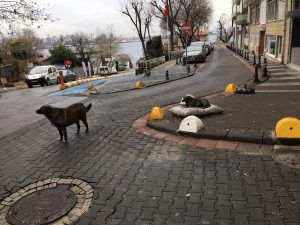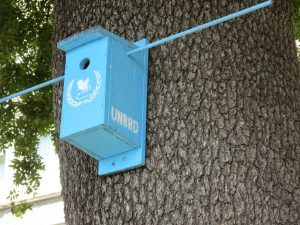by Holly A. Case

There is a nice neighborhood in Istanbul called Kadıköy, which means “village of the kadı,” or “judge.” One might as well call it Kediköy, however: “village of the cat.” There are a lot of stray cats there, as there are throughout the city. Once I saw a poster with a photo of a cat that said “Lost” at the bottom, then a phone number (rather like seeing a sign on the beach with a picture of a shell reading “Lost,” then a phone number). The sign was taped to a utility box on the street. On top of the box was a stray cat, lounging. It looked a lot like the one in the photo.
A few years ago, I met a retired architect who came down to the promenade along the reinforced shoreline every morning to feed the stray cats. “If there is a heaven and hell, which I don’t believe there is, but if there is, I will go to heaven on their prayers,” he told me.
In a different part of the city, my friend Kerim—a tailor—begins his two-hour commute to work at 6 a.m. Six days a week he pets the stray dogs on one side of the highway, then crosses to the other side to catch the bus where he meets a second pack of strays and pets them. Recently he constructed a luxury home for a stray cat who had taken up residence at the bus stop. It’s a cardboard box wrapped in plastic (to keep it dry), with a styrofoam roof (for insulation), a bubble-wrap subfloor (also for insulation), cardboard flooring, and an interior wall-to-wall rag (for extra comfort). He proudly showed me a photo of it with the occupant just visible inside.
In Istanbul, it’s not uncommon to see a street dog sleeping on a towel or a piece of cardboard, a dish of food nearby, and covered with a blanket by some local hayvansever (animal lover). Underneath an arcade in Kadıköy, someone has made a row of street-dog condos out of four very large cardboard boxes. Last week whenever I passed by at least two of the row-boxes were occupied by snoozing dogs. Municipal workers at the shoreline park also constructed and maintain a street-dog village with several wooden houses lined up in two rows behind the public restrooms. All official street dogs have ear tags, indicating that they’ve been vaccinated and spayed or neutered. In the summer some of the long-haired public charges are shaved to keep them cool.

Animal empathy has gone so far that it has even become the object of a socio-artistic satire. A few years ago, police rounded up thousands of Syrian refugees from abandoned buildings where they were congregating and bussed them back to camps near the border. The contrast with treatment of stray animals was not lost on a pair of artists, Evren Üzer and Otto von Busch, collectively known as Roomservices. They nailed a birdhouse to a tree overlooking the sea on the “Moda Nose” near Kadıköy—among the most prized pieces of real estate in Istanbul—with a long perch extending from both sides. The house was UN-sky-blue, painted with the acronym “UNBRD” (United Nations Bird Refugee Dialogue), in faux-internationalist-humanitarian-speak. A bird with the signature United Nations spangle of stars was visible just under the entrance hole. In thick grant-proposal-ese, the artists explained that the UNBRD was an “agency of reconciliation which invites communities to imagine, discuss and manifest the restoration of hospitality of urban environment for birds, in order to recall a common and shared heritage of hospitality.” (Needless to say, there were no actual birds living there.)
Not far from the birdhouse, there used to be a street dog camped out at an intersection in front of a realtor’s office. I recall him (or her) barking energetically, if not exactly to great effect, at unknown belligerents in defense of the building. The dog is no longer there, but there’s a monument—lovingly executed in concrete and bronze, complete with ear tag—of the dog lying on a large pillow.
Now there’s a new pack of street dogs on that corner. As I was about to cross the intersection the other day, one of them laid down on the sidewalk next to me, stretched to the nose in a very peculiar and tense pose. A garbage truck was rounding the corner and stopped in the middle of the intersection. The driver laughed at the dog and through the open window of the truck turned to me and shouted, “You see? He’s waiting for me! Watch this: When I turn the corner, he’ll bark!” The truck turned the corner and indeed the dog jumped up and ran after the truck, barking like mad, then turned around to take up his post again. A daily ritual apparently.
Kerim tells me street dogs have a thing with garbage trucks. It seems they disapprove of things being taken away.
